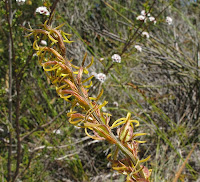Click image to enlarge
Tripterococcus brunonis - Winged Stackhousia
Tripterococcus is a member of the Celastraceae family, although until recently it was part of the relatively small (3 genera) Stackhousiaceae family, now discarded. Celastraceae has around 100 genera worldwide, with most being in tropical zones and generally known as Bittersweets. In the Esperance district there is only one of the three Tripterococcus species, the other two being rare and in the Perth coastal region. Tripterococcus brunonis on the other hand is very common, particularly in non-calcareous sandy soil from Israelite Bay (east of Esperance) to Kalbarri (500 km, or over 300 miles north of Perth).
Tripterococcus brunonis is a perennial herb or sub-shrub to ½ metre (18”) in height and usually comprises a few upright, largely leafless stems that are virtually undetectable amongst other plants when not in flower. The thin tubular flowers (around 1.5 cm or 5/8” diameter) are either yellow or green and grouped to one side of the stem. The fruits have three large wings (similar to some Hop Bushes) and three small wings between each larger pair, making them quite distinctive.
Although many may have seen these small plants, only a small number will have noticed a feature that to me makes this plant very special. To discover this characteristic, you need to go out on a windless night and if you are like me, be astounded by a strong, pleasant, but not overpowering perfume given off by the flowers after dark. Now I have a rather ordinary nose when it come to odours, but I can track these plants down by their scent alone, so their pollinators would have no trouble locating them.
The time of flowering can be almost anytime of the year depending on location and local weather conditions, but around Esperance most are in bloom from September to December. I have searched relentlessly to find the pollinators, but apart from a night flying Flesh Fly I have not seen any, however owing to the long tubular flowers (to 1 cm or 3/8”) it would have a long proboscis, as do many moths.







